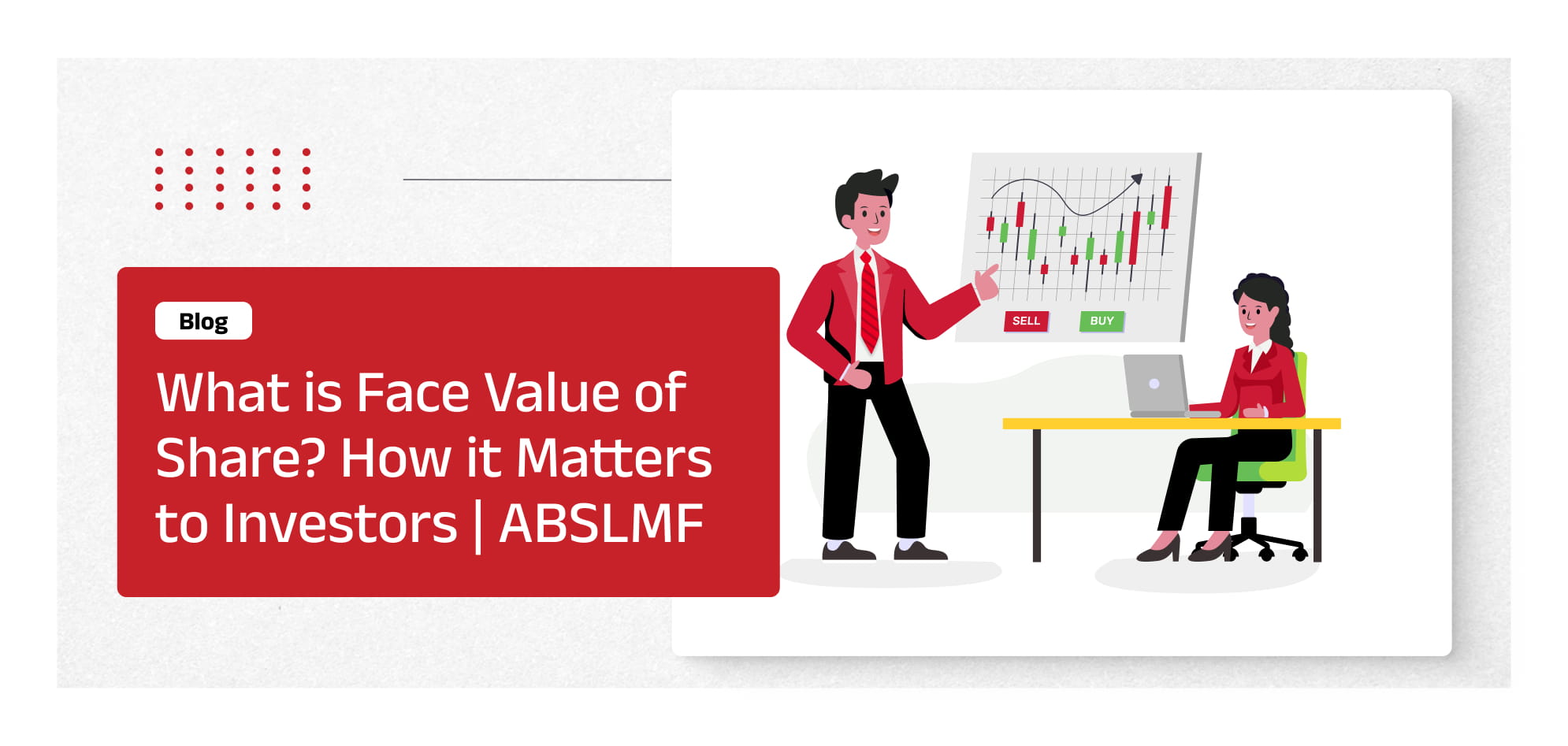-
Our Products
Our FundsFocus Funds
-
Self Care
Self-ServiceFind InformationWays To TransactPartner Solutions
-
Downloads
- Learnings
- About Us
-
More
-
Shareholders
-
Shareholders
-
Updates
-
-
SIP Calculators
- Back
-
Shareholders
What is the Face Value of a Share? Importance & Difference from Market Price

Aug 22, 2025
10 min
0 Rating
An understanding of the pricing structure of shares is essential to enter the investment market. But, with so many similarly named values, such as face value of share, par value, book value and others, confusion is common. Simultaneously, understanding the importance and differences between these terms is equally essential for informed decision-making regarding investments.
Hence, this article explores the face value in the share market and other such terms, helping investors differentiate between common terms and avoid misconceptions about share valuation.
What is the Face Value of a Share?
The shares, when issued by the company during events like an Initial Public Offering (IPO), are offered at a certain set price. This value is the face value of a share or par value and represents the nominal price assigned at issuance. These values are crucial for businesses as they set standards for accounting and legal purposes.
It remains constant unless changed by the company itself. The face value of the share is stated in the share certificates and may be changed in scenarios of corporate actions such as a share split.
The face value of the share formula is depicted as follows:
Face value = Equity share capital/ Total number of shares issued
Here, equity share capital is the total capital raised via equity shares, and the total number of shares refers to the number of shares issued by the company.
Difference Between Face Value, Market Value & Book Value
The face value of a stock is different from the market price and the book value. It is set by the company and generally remains constant. Now, let's explore the other two terms, market value and book value.
Market Value: It is the existing or current price at which the share is traded in the stock market. This value varies depending on the supply, demand, market conditions, industry trends, market sentiment, and company performance. The market value of a share changes daily.
Book Value: It is the representation of the Net Asset Value (NAV) of a company. It indicates the company’s financial health, and investors can accordingly evaluate the company’s intrinsic value to analyse whether it is over- or undervalued. The book value varies depending on financial performance, asset values, and liabilities.
The book value is calculated using the formula:
Book value = Total assets - Liabilities
Role of Face Value in IPOs and Dividends
Let’s understand the role of face value in IPOs and dividends:
IPOs: The face value is the nominal value of a company’s shares set by the issuer. In an Initial Public Offering (IPO), the issue price is usually higher than the face value, with the difference treated as a premium. Issue price is the price at which shares are first sold to the public. The face value determines the share’s base pricing structure and accounting in IPOs.
Dividends: Dividends are a part of the company’s profit paid to the shareholders. Dividends are typically declared as a percentage of the face value, making it an essential metric for investors aiming to earn income.
How Face Value Affects Stock Splits and Bonuses
The impact of the face value on a stock split and bonuses is as follows:
Stock Splits
A stock split is a situation in which existing shares are divided into multiple shares. It makes shares more affordable and improves liquidity. Also, it has an impact on the face value of the shares.
Let’s understand this with an example:
There is a company with shares of INR 5. If it announces a stock split of 1:3, then the impact will be:
You will have three shares for each share you own
Face value of each share will reduce to INR 1.67 approx
Market price will adjust accordingly, and the previous market price (let’s say it was INR 600) will be reduced to 1/3rd (INR 200)
Now, if you owned around 150 shares before the split (worth INR 90,000 at INR 600 each), you would now own 450 shares after the split (still worth INR 90,000 at INR 200 each)
Hence, while the investment value remains unchanged, you own more shares at a proportionately lower price. Another key concept to know here is share consolidation. It is also referred to as a reverse stock split. It is simply the reverse, as it combines the multiple shares into one, thus reducing the number of shares and subsequently increasing the face value.
Bonuses
A bonus issue or capitalisation issue involves offering more shares to the shareholders for free. It is the reward from the company when it reports strong financial performance and is based on a certain ratio. The face value determines the accounting of these new shares, as the bonus shares are credited at face value from the company’s reserves. While the market price adjusts proportionally, the shareholder’s overall investment value remains unchanged.
Common Misconceptions
Some of the common misconceptions surrounding the face value in the share market are:
Face value determines the worth of the company.
Reality: The company’s worth is determined by market cap, earnings and performance.
Face value impacts the stock price.
Reality: The stock price varies depending on the company's earnings, demand, supply, popularity and other factors.
Face value represents the market price of a share.
Reality: The market value and face value are different entities, as explained previously.
Shares can not be traded below their face value.
Reality: Generally, shares are issued at a price above face value. But the alternate situation is possible during poor company performance, losing market share or poor financial conditions.
You get face value when you sell shares.
Reality: Selling leads to earning the market price and not the face value.
Importance of Face Value in Stock Analysis
The importance of face value in a stock analysis is indirect and is listed as follows:
Helps calculate Earnings Per Share (EPS), Price to Earnings (P/E) ratio, Return on Capital Employed (ROCE) and Return on Equity (ROE) ratio.
Useful in calculating premiums and the stock’s current value
Acts as a reference point for calculating dividends when companies declare them as a percentage of face value
Useful in stock splits and bonuses affecting investors' perception and shareholding patterns
Conclusion
The face value’s meaning in share markets is a fixed value that generally remains constant. It is essential for dividend calculation, financial reporting, IPO structuring, and corporate actions like stock splits and bonuses. The face value is also known as par value and differs from market value and book value. It is recommended to gain thorough insights before proceeding to analyse the shares based on these values.
The information herein is meant only for general reading purposes and the views being expressed only constitute opinions and therefore cannot be considered as guidelines, recommendations or as a professional guide for the readers. The document has been prepared on the basis of publicly available information, internally developed data and other sources believed to be reliable. Recipients of this information are advised to rely on their own analysis, interpretations & investigations. Readers are also advised to seek independent professional advice in order to arrive at an informed investment decision.
Mutual Fund investments are subject to market risks, read all scheme related documents carefully.
Face value refers to the initial price of a share when it’s first issued by a company during an Initial Public Offering (IPO).
Face value is a fixed nominal value of an asset, while market value fluctuates depending on the market conditions.
Face value does not directly impact the investment returns. However, it is used for certain calculations, such as dividends, when shared as a percentage of the face value.
Face value in an IPO is important as it indicates the nominal value of the shares when it is first issued.
The face value may change due to corporate actions such as stock splits or reverse stock splits. Besides these, there aren’t any reasons for changes in face value over time.





 1800-270-7000
1800-270-7000



